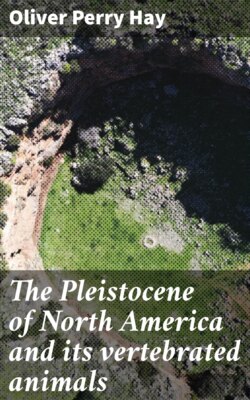Читать книгу The Pleistocene of North America and its vertebrated animals - Oliver Perry Hay - Страница 12
На сайте Литреса книга снята с продажи.
VII. The Richness of the Pleistocene Vertebrate Life.
ОглавлениеTable of Contents
It will be profitable to consider briefly the character of the Pleistocene vertebrate fauna. The writer has compiled a list of the species which have, so far as he knows, been collected and described up to this time. There are in all 637 species; of these, 387 belong to the mammals, 154 to the birds, 26 only to the reptiles, 7 to the amphibians, 56 to the bony fishes, and 7 to the group of sharks and rays. Certainly these form only a part of the species which existed. At present there are known in our existing fauna north of Mexico 693 species of mammals, excluding the cetaceans—somewhat more than twice the number of known Pleistocene species. It is, however, rather in the great variety of forms that the Pleistocene excelled. Following Gerrit S. Miller’s Land Mammals of North America, 1912, we find in our present fauna north of Mexico 29 families; in the Pleistocene there are now known 37 families, not including the cetaceans. In our existing mammalian fauna there are recognized 111 genera; in the Pleistocene, with hardly half as many species recorded, 138 genera are counted. In order to realize more vividly the variety of Pleistocene forms, we have only to recall the animals then present, now absent, namely, the great ground-sloths, the glyptodons, the numerous species of horses, tapirs, numerous peccaries, camels, the extinct relatives of the musk-oxen, extinct bisons, elephants, mastodons of three or four genera, the giant beaver, and the saber-tooth tigers. Among the birds, reptiles, batrachians, and fishes, there were few striking forms, and these were mostly among the birds and the tortoises.
The above account shows the great richness of the vertebrate life during the Pleistocene; furthermore, this abundance evidently existed during the early stages of the epoch. It constituted the materials on which that combination of conditions which we call environment had to work during Pleistocene times. The comparison shows that the result was an impoverishment of the vertebrate fauna. Genera and families, even orders, were wiped out of existence, and these included some of the noblest animals that have graced the face of the earth, the elephants, the mastodons, tapirs, many species of bison, horses, saber-tooth cats, huge tigers, and gigantic wolves. The following nine or ten families became either wholly extinct or continued to exist only in other more hospitable lands: the Megatheriidæ, including several genera of ground-sloths; the Hoplophoridæ or glyptodons; the Caviidæ, which embraced one or more species of huge capybaras; the Elephantidæ, under which are arranged three or four species of elephants and three genera of mastodons; the Equidæ, represented by a dozen or more species of horses; the Camelidæ, of which there were several Pleistocene species and probably three or four genera; the Hyænidæ, of which there appears to have been at least one genus, with one species; the Tapiridæ, including three or four species; and probably the Rhinocerotidæ. Besides these, the subfamily of Felidæ known as Machairodontinæ, embracing those wonderful carnivores the saber-tooth tigers, was suppressed. The Dasypodidæ, which included some armadillos 5 or 6 feet long, are now represented by only one small species in Texas. Of the Tagassuidæ, to which belonged several genera and stately species of peccaries, there exists now in North America north of Mexico but one species, an animal of only moderate size.
